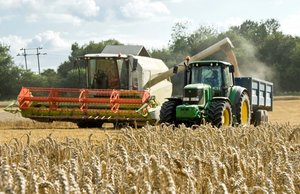
English wheat harvest 2016
8th July 2016I have just attended the funeral of a former colleague. One reading included the following words: “There is no longer any room for pretence. At harvest time the essence is revealed – the straw and chaff are set aside, they have done their job. The grain alone matters – sacks of pure gold.” Sacks of pure gold may be an exaggeration with today’s market prices.
What will the English wheat harvest of 2016 reveal? Over the last few years I have written a blog in early July, half way through grain fill, trying to predict yields. As usual, I have not really got sufficient meteorological data to attempt a complete scientific analysis. Nevertheless, here goes.
There have been studies to try to associate historical wheat yields with weather conditions. The most notable was published in 2000. This states that the most influential weather impacts on the yields of well grown wheat crops are (1) negative effects of rainfall before and during anthesis (early June), during grain-filling and in the spring (2) winter frost damage (3) a positive effect of the temperature-driven duration of grain-filling and (4) a positive effect of radiation around anthesis, probably due to increased photosynthesis.
Naturally, there may be an interaction between rainfall and solar radiation. Radiation levels are low in wet weather. This might help to explain some of the dominance of rainfall distribution in this analysis.
The importance of lack of rainfall at key times is highlighted. “Negative effects of rainfall during the estimated early-reproductive phase, the estimated anthesis phase, the estimated grain-filling phase and the February/March period are the most dominant effects in the climate response sub-model (explaining 54% of the grain yield variation accounted for by the model).”
This strikes a chord with my experience. High wheat yields seem to be associated with dry but not drought years e.g. 1984, 2014, 2015. May rainfall explained much of the yield variation throughout the country last year. Where there was little rain in May, drought conditions limited the potentially very high yields.
In 2014 and 2015, we had dry conditions from mid-February/March, April and June, the stages highlighted by this paper. In addition, we had a long grain fill because of coolish conditions both day and night (Number 3 in the paper summary above) and good levels of radiation around anthesis (Number 4 in the paper summary above).
For much of the country, this year’s weather does not appear to point to high yields in 2016. February had average or lower than average rainfall and March was dry in the North East but the rest of England had a wetter March than average. We had plenty of rain in June in much of the country but again the North East had average rainfall. Radiation levels were generally around average for much of the spring but, critically, lower than average in June, except in the North of England, which enjoyed average or above average sunshine and radiation. June temperatures were higher than average except close to the East Coast where the cold North Sea temperatures resulted in average temperatures in the coastal strip from North Norfolk northwards.
Therefore wheat yields are likely to be around average, perhaps on the disappointing side of average in the central and southern areas that have had particularly low levels of radiation and well above average rainfall for June. The exception might be the very North of England where I suspect that there will be above average yields but perhaps not at the levels achieved last year, providing, of course, that the harvest weather is good.
The paper I quoted earlier in this blog probably reinforces rather than forms my somewhat instinctive conclusions. As usual, I hope yields will be better than I predict!

